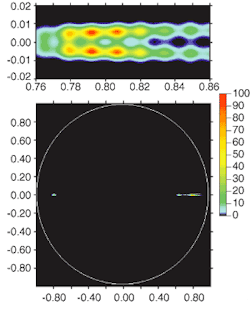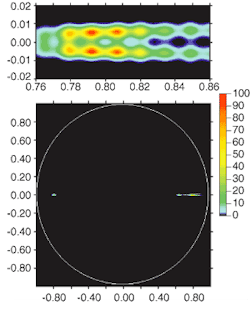Droplets shine white light back at laser
A group of European and American scientists has discovered a way of making water droplets emit a beam of white light (and then explode). The light and subsequent self-destruction are caused by the creation of plasma within the droplets. The phenomenon may one day make it easy to remotely determine the chemical constituents of aerosols.
Researchers from the Université Lyon (Villeurbanne, France), the Army Research Laboratory (Adelphi, MD), Yale University (New Haven, CT), and the Freie Universität Berlin (Berlin, Germany) bombard small droplets with ultrafast laser pulses, which are focused by the droplets' spherical shape, then partially reflected off their back surfaces.1 Multiphoton absorption at the internal focus causes laser-induced breakdown and ionization of water, further absorption of laser light, and production of white light. The light is nonpolarized and corresponds to blackbody emission.
Because the white light is emitted from the point the laser beam is absorbed, it forms a beam that retraces the path of the incoming laser light. "You have a situation similar to a very tiny light bulb placed very eccentrically at the internal focus of a glass microlens," says Véronique Boutou, a Université Lyon researcher. "You thus refocus the emitted light in the incoming direction. The situation can be seen as an example of the reciprocity principle."
A Ti:sapphire laser emits 120-fs pulses at 810 nm at a 20-Hz repetition rate. Droplets 50 to 70 µm in diameter are produced in time with the laser pulses so that each pulse hits one droplet. The near-infrared wavelength of the source means that five photons must be absorbed to ionize one water molecule. The far-field angular distribution of the white-light beam shows a lobe at 150° in addition to the 180º return beam.
"Yes, the droplet explodes," says Boutou, "but on a nanosecond time scale, probably. That is the strength of the ultrashort interaction. Using femtosecond laser pulses means that we can benefit from a high peak power—which can trigger many nonlinear effects—but without depositing much energy in the interaction. This preserves the integrity of the droplet for a while—at least for tens of picoseconds. Moreover, electrostriction and other processes like that are avoided. The amazing characteristic of these droplets under femtosecond excitation is that they do not deform (because the deposited energy is low, although the intensity is very high) and thus they concentrate the incoming laser light extremely tightly."
If the droplet contains substances in addition to water, they may signal their presence with emission lines. For example, the researchers experimented with salt-containing droplets, finding that the sodium D1 and D2 lines were easily detectable, though not separately resolved.
Tests on aerosols in nature are in the works. "In our case, the application is remote detection and identification of atmospheric monitoring, such as water droplets or biological aerosols," says Boutou. "Water droplets are strongly affected by air pollutants (acid rain and fog are examples) and it's a real challenge to detect and identify remote biological aerosols. Basically you need them to measure the composition of the aerosol particles and laser-induced breakdown is an attractive possibility."
The Teramobile—a femtosecond terawatt laser intended for light-detection-and-ranging experiments, and powerful enough to create plasma within far-off water droplets—was developed by the Université Lyon, Freie Universität, and other European researchers and built by Thales Optics (Palaiseau, France; see Laser Focus World, January 2002, p. 37). "With this system, we now plan to do these experiments directly in the clouds," says Boutou.
REFERENCE
- C. Favre et al., Phys. Rev. Lett. (July 15, 2002).

